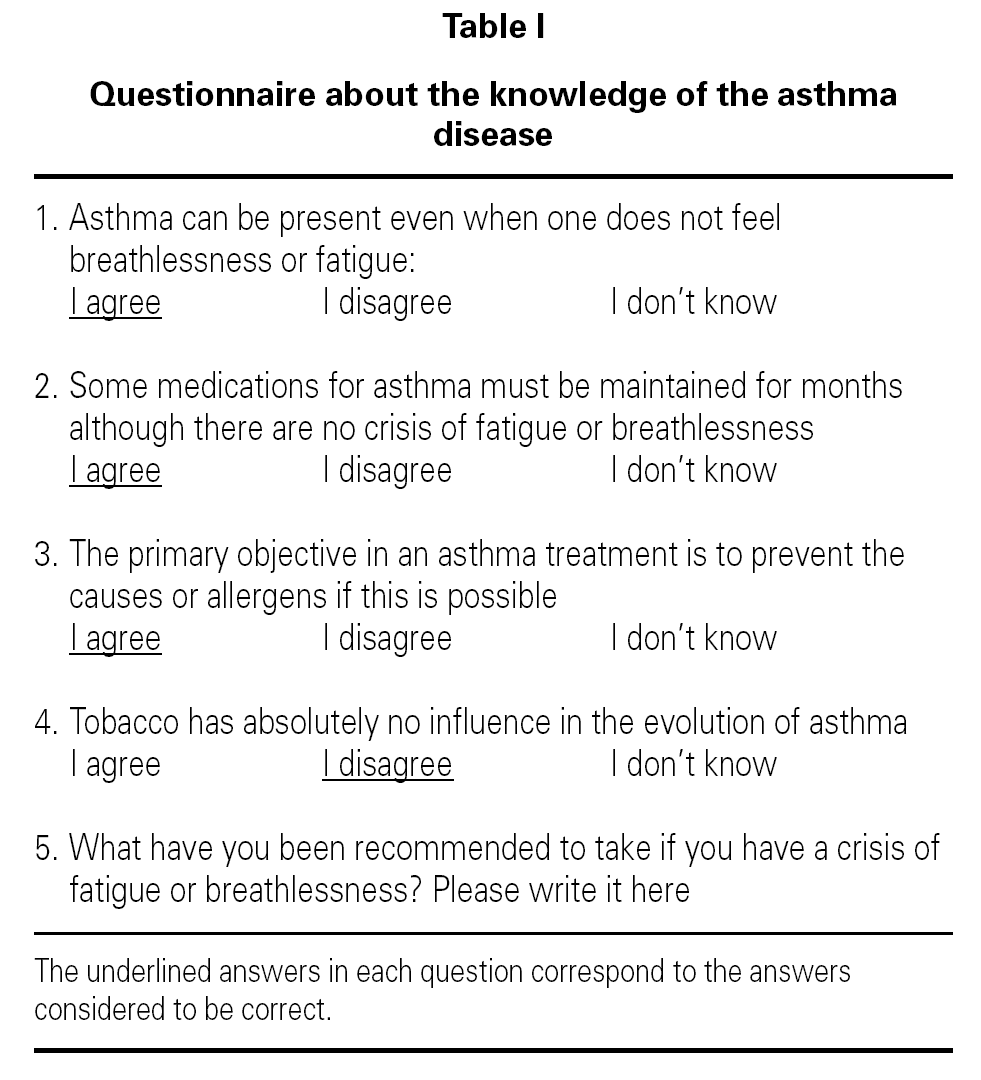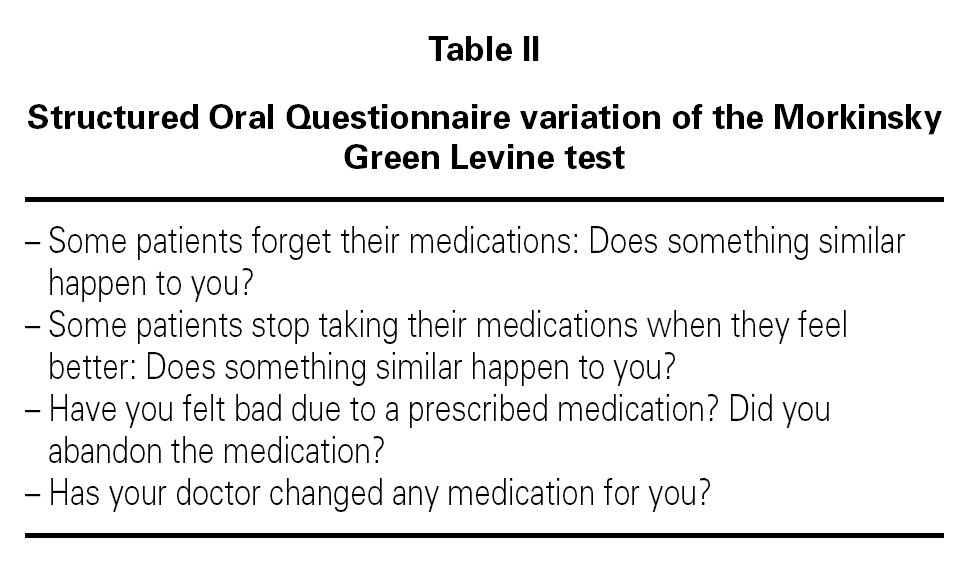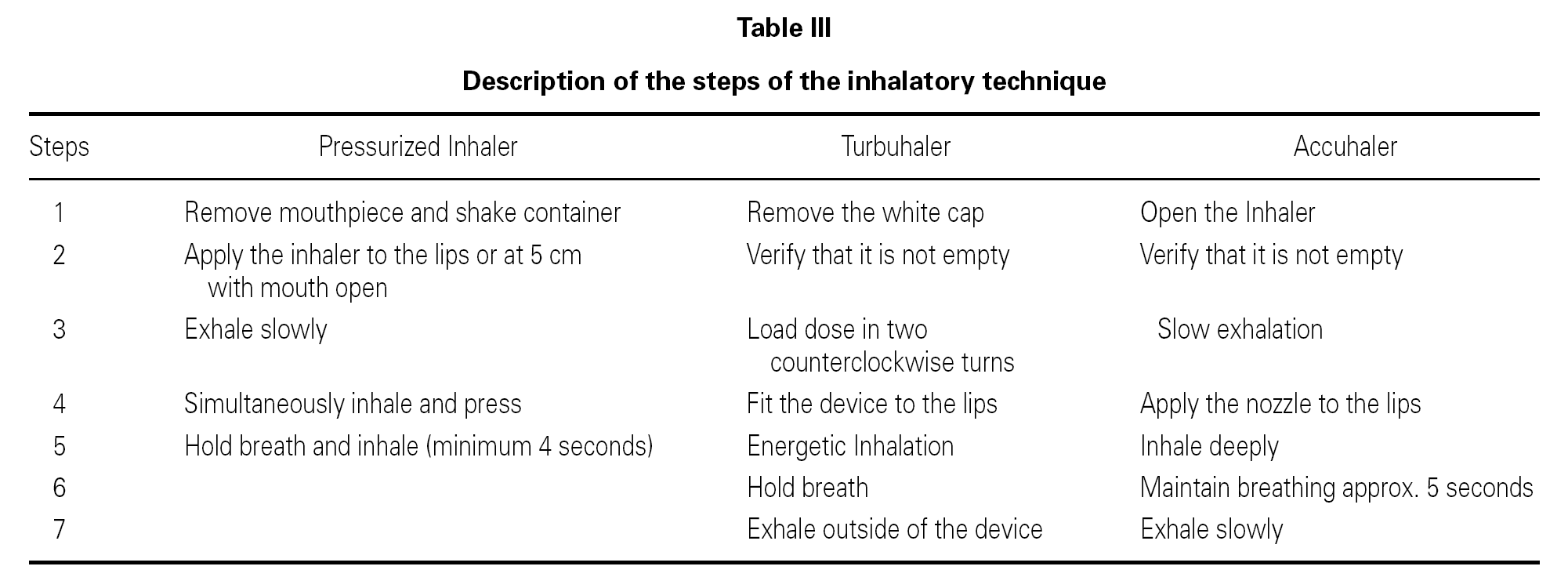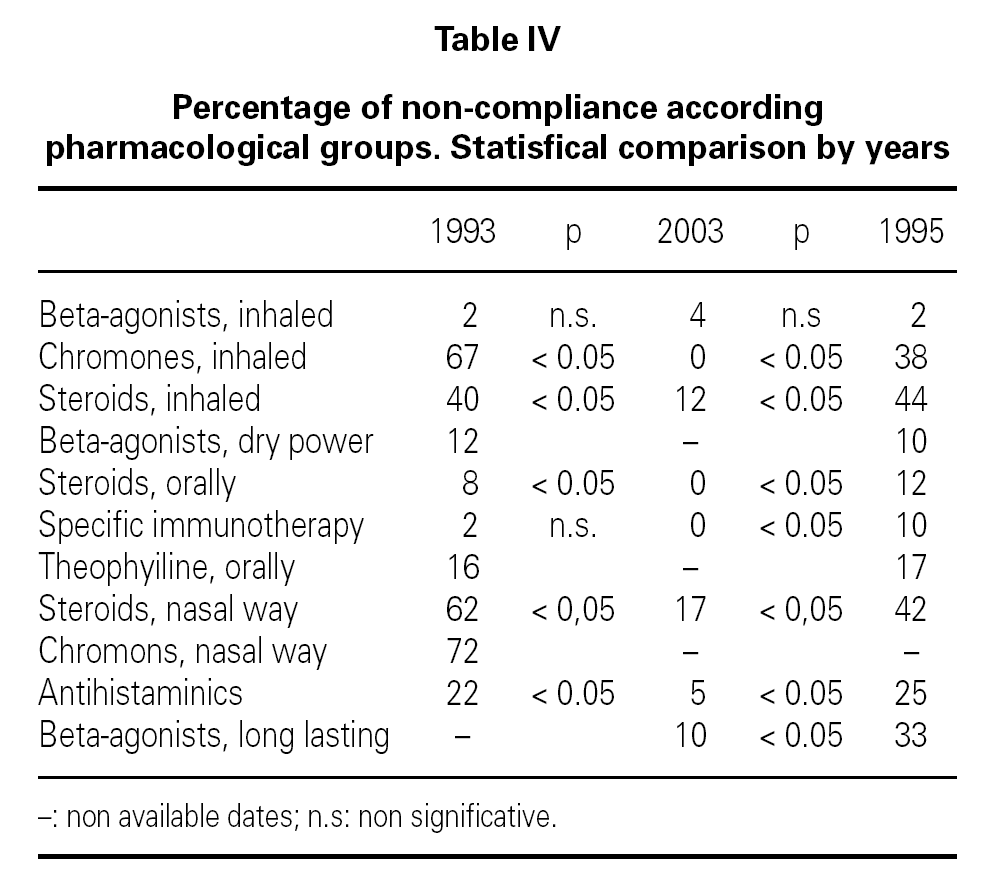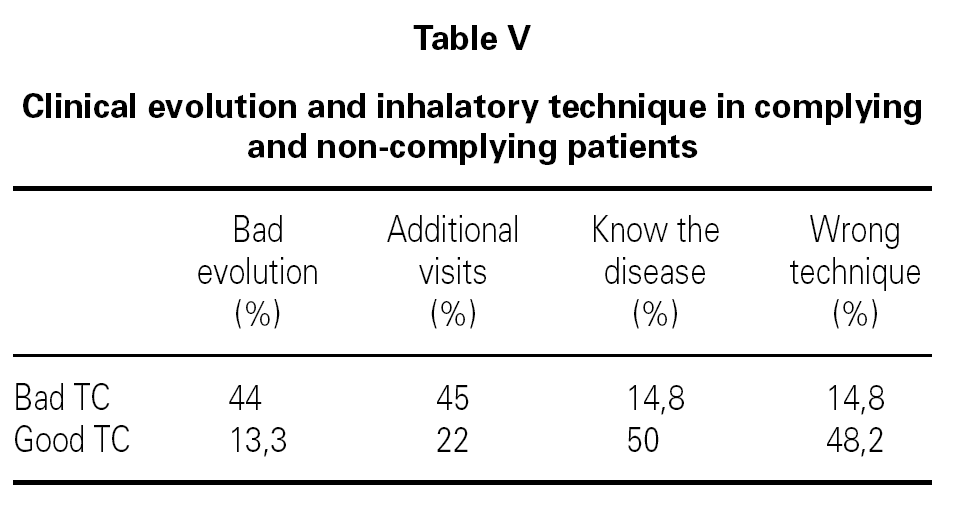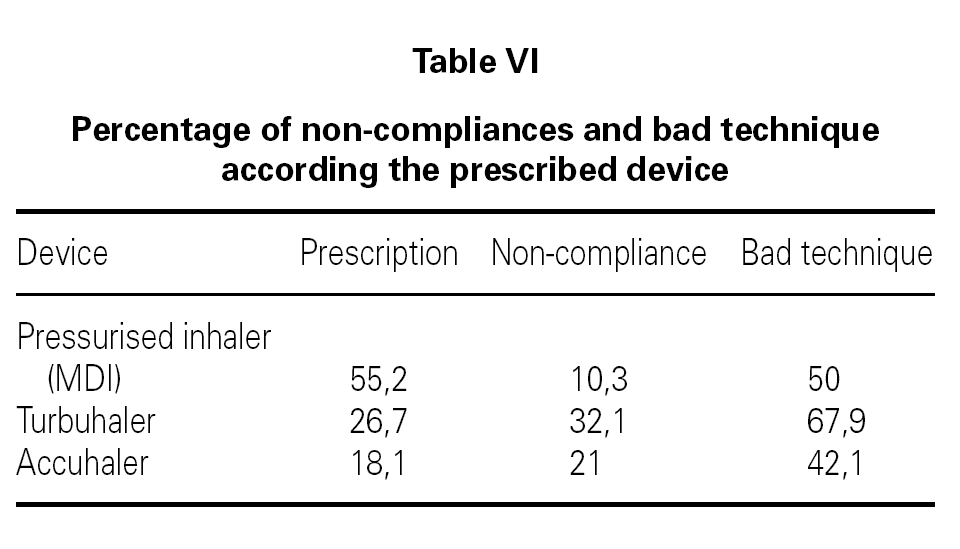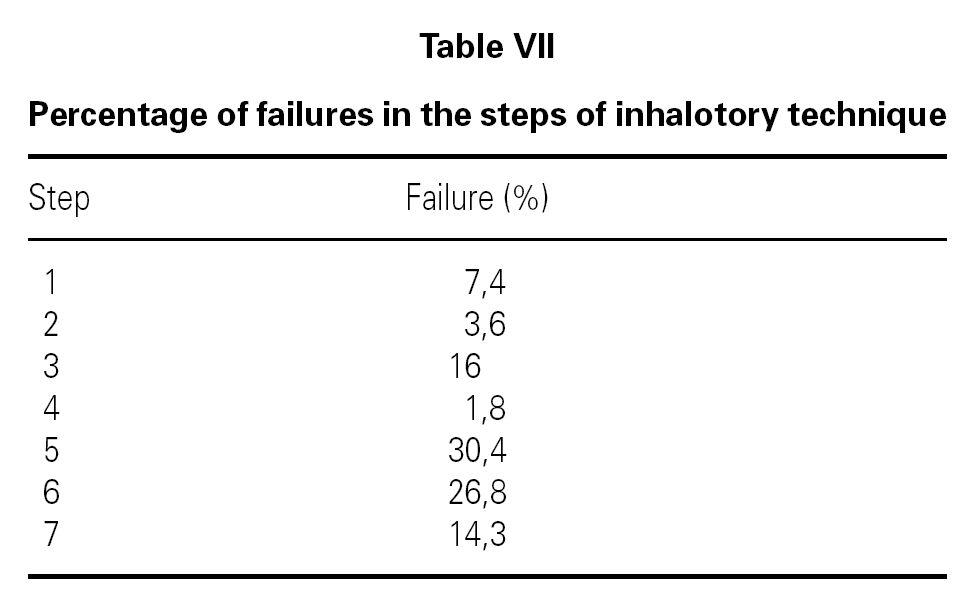INTRODUCTION
The suitable compliance with the treatment orders (TC) prescribed for patients continues to be a crucial question in the handling of patients with chronic diseases such as what occurs in the case of bronchial asthma. It has been postulated as an influential factor in the clinical evolution in the form of an increase in morbimortality 1.
The patient's own clinical evolution can occur with long asymptomatic periods and on the other hand, the characteristics of some "maintenance" medications, such as anti-inflammatory drugs without immediate perception in their effects, which induces a certain relaxation in the TC maintenance 2.
Excluding the specific case of clinical tests, it assumes that the TC in clinical practice, understood as the suitability of the unit doses, daily rate, and their duration in time, can be situated for approx. 50 % of the patients, according to the published series 3,4.
In 1993 and 1995, we carried out the aforementioned studies 5,6 designed to analyze the pharmacological compliance of asthma patients controlled in the outpatient visits to our department, where it was observed that 70 % and 51 % of the patients in the sample failed to comply with the prescribed treatment.
Another relevant factor in the clinical evolution is the correct performance of the technique for the different inhalatory therapy devices 7,8. Although it must be said in relation to the degree of the patient's own awareness of his disease, so that he/she assumes a greater knowledge about the suffered process consequently resulting in a better therapeutic compliance.
Thus we propose it as a primary objective to evaluate the TC of our patients in the daily clinical practice and its breakdown by pharmacological groups in asthma patients controlled in our department. As a secondary objective, we plan to correlate the TC with the asthma patient's degree of knowledge about his illness as well as with the inhalatory technique.
MATERIAL AND METHODS
This involves a descriptive cross-section study. An identical methodology was followed for the studies performed in 1993 and 1995 5,6,8. The procedure basically consisted in a random sample with a fixed rate (first and third patient of each day) comprised by 54 adult asthma patients (above the age of 18) controlled in our department in an outpatient regime in order to detect and quantify the degree of compliance with the different pharmacological groups prescribed in relation to their bronchial asthma and occasionally their accompanying rhinitis. It also evaluated the inhalatory technique and the asthma patient's degree of knowledge about his illness (table I).
The study was carried out from October to November 2003 and the selected sample included the asthma patients reviewed in outpatient clinics in at least two occasions, corresponding to all the doctors of the department. First visits were excluded from the study due to the difficulty to objectify the treatment prescribed by doctors from other hospitals.
Patients were invited during the habitual medical interview to declare their pharmacological compliance by means of a structured oral test inspired by the Morinsky Green Levine 9 test for the control of arterial hypertension, which appears in table II, used in prior evaluations.
A non-complying patient for the medication in question was considered in the cases in which the patient admitted that he/she habitually failed to comply with the duration of the treatment, the number of dosage times per day, or the dose at each specific dosage time in relation to the treatment recorded in his/her medical history.
The same medication categories were used as those employed in the 1993 and 1995 studies. Additional parameters were collected, such as the clinical evolution (good or not good) according to the criteria of the responsible doctor, additional visits to emergency rooms, specialists from other hospitals and admissions due to problems related to their bronchial asthma, and the patient's degree of knowledge about bronchial asthma based on a questionnaire with four questions (table I), in a way which considered that the patient knew about his/her own disease if he/she responded in a correct way to all of them.
With regards to the inhalatory technique, it considered that the patient carried it out in a correct way when he did not fail in any of the steps which are shown in table III, in accordance with the manufacturer recommendations of the device. It collected the total number of erroneous steps and the ones which were incorrectly performed by the patient.
The statistics package, SPSS® v11.0 for Windows® was used in the analysis.
The description of the variables was performed by means of percentages with a confidence interval of 95 %. A chi-square was used for the comparison of the proportions, previously verifying the normality of the variables and the homogeneity of the variances by means of the Levene test.
RESULTS
The mean age of the patients was 45.1 (Standard Deviation [SD] of 16.7). The mean evolution of the asthma disease was 17.6 years (SD 11.6), where 64.8 % were female and 35.2 % were male.
Of the 54 patients studied, 19 % revealed some type of pharmacological non-compliance. The percentage of incorrectly-used medication in this study was 8 %.
Table IV describes the percentage of non-compliance broken down in pharmacological groups in 1993, 1995, and 2003.
44 % of the non-complying patients had a bad clinical evolution according to the doctor criteria, compared with 13.3 % who had good TC. 45 % of the non-complying patients required additional visits to specialists or to the emergency rooms compared with 22.2 % of patients who correctly complied with the treatment. Of the total of additional visits, 11.1 % were admitted to hospital; 22.2 % made visits to the emergency room, and 66.7 % clinical visits to specialists.
Table V describes the percentages of patients that presented a bad clinical evolution of their disease and additional visits to emergency rooms, specialists from other hospitals, and admissions due to problems related to their bronchial asthma; as well as the percentage of patients that knew about their disease and those that incorrectly performed the inhalatory technique based on their good or bad TC.
The percentage of failures in the inhalatory technique and non-compliances by the prescribed device are described in table VI.
31.5 % of the patients failed in only one step, 25.9 % failed in two, and the remainder failed in three or more steps. Table VII shows the percentage of failures in different steps of the inhalatory technique. The greatest percentage of failures in the inhalatory technique are registered in both the post-inhalation apnea and in the energetic inhalation after fitting the device to the lips.
DISCUSSION
This study shows a decrease in the historical tendency of the degree of non-compliance by the patient and the number of incorrectly-used medications in relation to the years 1993 and 1995. We have changed from 70 % in 1993 and 51 % in 1995 to the current 19 %. If we compare the percentage of current incorrectly-used medications with those of 1993 and 1995, we find the current 8 % as opposed to 35 % and 20 % respectively, where the differences for both the non-compliance by the patient as well as the incorrectly-used medications are statistically significant (p < 0.05).
Given that therapeutic non-compliance is situated between 40 % and 92 % (10.4) for bronchial asthma, we can consider that we have good pharmacological compliance.
In relation to the incorrectly-used pharmacological groups, it detected a major statistical decrease for the steroids inhaled in dry powder form, the nasal steroids, and the long-lasting beta adrenergics.
It seems to observe, although without statistical meaning, a greater proportion of additional visits both to emergency rooms as well as to specialists in the patients that fail to comply with the pharmacological treatment. This fact can possess an interesting "tracer" relevance for individual cases. In a way which supports the empirical idea, above all for patients with a bad clinical evolution, the TC must be guaranteed in the first place.
Paradoxically, there is a significant statistical dissociation between the good TC and the correct performance of the inhalatory technique, which in our case, seems to get worse with the passage of time. One possible explanation can consist in the attention that we dedicate to this topic with our patients. This could mean that in daily practice, we have interiorized the systematic revision of the TC and we probably devote less attention to the verification of the inhalatory technique.
If we compare the inhalatory technique of the current study with that of 1995, 62.9 % of the studied patients incorrectly performed the inhalatory technique, as opposed to 44 % of the patients in 1995, where there is a significant statistical difference, p < 0.05.
Flor et al 11 detected that 53.9 % of the patients performed an incorrect technique, where the manoeuvres with the greatest percentage of error, the exhalation prior to the inhalation, the maintenance of the post-inhalation apnea, and the slow exhalation after the inhalation.
Finally, as we concluded in previous studies, we consider that the evaluation of the TC and the inhalatory technique form a part of the habitual clinical follow-up protocol for asthma patients.
Correspondence:
A. Campos
Hospital Universitario La Fe
Avda. Campanar, 21
46019 Valencia. Spain
E-mail: campos_ang@gva.es



